


Salute, soldiers!
Welcome in this miniguide to Wargame AirLand Battle. You will fight with rotten imperialism or convert to imperialism peaceful soviet nations leading by forever soviet Scandinavia. Whatever you choose, with us you'll go from a Compote (People's Army of Poland warrant officer) up to a real War Dog (colonel) Become a general on your own.
In this guide, you'll mostly find advices, thanks to which you won't be a whipping boy. To become the beating one, you'll have to spend hours with this title and show a lot of commander talents.
This guide will help you:
As the in-game campaign and the human, against who you'll be fighting in the multiplayer, are not linear, treat this little guide as a war orchestra. We will help you get to know about it particular tools and tell you how to use them effectively, so your own predispositions will decide about winning or losing.
And so I'm showing and explaining.
()

In the game, NATO is represented by eight nations - USA, France, United Kingdom, Federal Republic of Germany, Canada, Sweden, Norway and Denmark.
General characteristic of all NATO armies: most of states have better air force, better equipped infantry (some nations have chosen a war doctrine basing on avoiding panzer encounters and preferred to act irregularly until the intervention of stronger allies), weaker tanks (Danish or Canadian tanks are weaker than the medium equivalents in Warsaw Pact) and, what is very important, bigger variety of units due to the number of nations developing their own, independent armies.
You should use armies of USA, Sweden, West Germany, France or UK to make nation armies because the remaining ones are less universal and work better as elements of the international deck, where you can use their advantages.

USA (US)
The strongest faction in NATO and easiest to play, so it's a good choice at the beginning, when you learn how to play. You should notice also, that the equipment of the remaining nations bases strongly on the USA. That's why, you should this army, as you'll surely meet with their weapons (better not as a victim). USA has the widest choice of units and the best air force in the alliance. Besides universal and expensive Abrams, full of electronics (the best stabilizers), the tanks aren't impressive when you check their prices. Also infantry is rather average, but the transport is rather ok.

France (FR)
France Army, adjusted to the colonial war, is good in actions requiring a lot of mobility and ambushes, while it prefers light and quick but very fragile units. Unfortunately, lack of stabilizers in the most of tanks make them difficult in use during the maneuverable battles. You can also notice a lack of anti-aircraft infantry and presence of unconventional helicopters.

United Kingdom (UK)
British Army is one of the three panzer forces in the Alliance (next to the West Germany and USA), but their heavy tanks may have a problem when the front is moving very quickly. In case of offensive actions, notice strong and quick infantry.

Federal Republic of Germany (FRG)
This army has perfect but very expensive late-generation tanks and strong infantry. But helicopters and planes are rather weak.

Sweden (SWE)
This nation has strong tanks (stronger than all nations below), strong infantry and a cheap recon, but it has relatively weak (according to nations above) air-force and artillery.

Canada (CAN)
Canadians have not bad infantry with great and quick transport (helicopters) with nice air force but their anti-aircraft forces is a mess - only infantry and advanced, but expensive system ADATS). And their old-fashioned tanks are better only from Danish and Norwegian ones.

Norway (NOR)
Norway infantry and high-tech air force make this army pleasant and not difficult to play. But you should base your force on infantry, as the tanks are useless.

Denmark (DAN)
Danish forces are quick and light, with very cost-effective infantry and cheap anti-infantry helicopters. Weak and narrow choice of tanks, lack of anti-vehicle infantry and high-tech air force.

In this game it contains USSR, Poland, Czechoslovakia and German Democratic Republic. The assets of Warsaw Pact are better panzer forces than NATO, cheaper air force, excellent assault helicopters (every army has Mi 24). As it was in the reality, all armies in Warsaw Pact are equipped or basing on the soviet weapons and technology. So all of their forces are similar.

USSR (URSS)
Equivalent of USA. Soviets have the most variable units among all nations within the WP and the best air force. Their tanks are much better than the ones of USA. Infantry is rather average, better is specialized infantry and transport. Most of the players choosing the red side, choose USSR, but, as it was mentioned, most of armies of this side bases on the soviet weapons.

Poland (POL)
As in the case of GDR, Poland was gifted with the out-dated weapons by USSR. Lacks of more advanced tanks are balanced by good, various infantry and offensive and strong artillery. Air force is cheap and out-dated, what means it's weak. But Poland has the widest choice of helicopters, right behind the USSR.

German Democratic Republic (RDA)
Assets of this army are good recon, various air force and wide choice of good infantry in quick transporters. This nation, like USSR, has an anti-aircraft plane. As in the case of Poland, tanks are only average.

Czechoslovakia (TCH)
Nation equipped in their own equivalents of soviet weapons. Czechoslovakia has various, anti-tank infantry, average air force and tanks similar to those of Poland and GDR. This army's asset is good artillery.
Game divides units on the following categories:

Below you find a list of icons (on the left NATO, on the right WP) and name of units marked by them:
NATO
WP
Description


Command vehicle - jeeps, all-terrain vehicles and other unarmored and unarmed (besides M1025 - Humvee CP) cars. They cost between 100 and 110 points. More expensive models are a bit faster.


Command helicopter - flying equivalent of other command vehicles, unarmored and unarmed (besides armed with UKM Mi - 4 AVPK). Only Poland, France, USSR and USA can buy it. Cost: 100 - 110 points


Supply helicopter - unarmed and unarmored transport of reinforcement. Cost is from 25 to 125 points. Denmark, Norway, Czechoslovakia and FRG has no supply helicopters


Truck - unarmored cars carrying supplies. When hit, explodes or damages nearby units. Cost: 10 - 30 points


Armored truck - armored only by name (besides MPT - LB), but endure (10 points of Strength instead of 5). Cost: 10 - 40 points, only USA, Czechoslovakia, GDR and USSR can buy it.


Command tank - the name says all. In general, they have rather average stats. Cost: 165 - 250 points
NATO
WP
Description


Shooters, commandos - motorized infantry with different level of skill and equipments. The typical squad has firearm, anti-tank weapon and machinegun (besides Heimatshtzen, Reserveshtzen and Reservistes, who don't have machineguns). Better troops fire rapidly, they have also machineguns for melee and, sometimes, anti-tank launchers (ENYX, Metis). There are 10 to 15 (more expensive and better equipped troops), speed 18 km/h, cost 5-25 points, to which you have to add costs of transport (with trucks, armored carriers, helicopters). Royal Marines, Kustjgare and Commandos use the same symbol.


Commandos - perfectly equipped and trained troops. They are faster (27 km/h) and fire better than the regular infantry. They use also more various weapons, like anti-aircraft missiles r napalm launchers. They have weaker stealth, optics ("good") and speed than special troops marked with this same symbol from the category of "Recon". Cost: 25 - 35 points


Engineers, sappers - troops adapted to eliminate fortified points of infantry defense. They use incendiary weapons. Troop of sappers has only 5 men and is equipped in thermobaric rocket launchers, while the engineers have 10 men in squad and use classical flamethrowers. Cost: 10 points for engineers (besides assault sappers - 15 pkt) and 15 points for sappers.


Anti-tank - infantry specialized in destroying tanks. Their price and efficiency depends on the quality of grenade launchers and anti-tank launchers used by them. Squad counts from 2 to 5 men and costs from 10 to 30 points.


Anti-aircraft - equivalent of anti-tank, destroying flying objects. Squad counts 2 soldiers (besides RBS 70 and Lvgrp RBS 70 which counts 5 men), cost from 5 to 20 points)
NATO
WP
Description


Anti-aircraft artillery (radar) - vehicles with anti-aircraft cannons using a radar. They use automatic cannons (including 4x), coupled cannons and gatlings. They fight better against helicopters than planes. Cost 20 - 70 points


Anti-aircraft artillery - like above, but cheaper and less efficient. They don't use radar so they are not exposed for planes destroying anti-aircraft defense. Cost: 10 - 50 points


Anti-aircraft missile (radar) - mobile surface-to-air missiles launcher, efficient against all types of air forces. Cost: 20 - 85 points


Anti-aircraft missile - like above, but without radar (so the missiles aren't guided). Cost: 20 - 45 points, except ADATS (90 points)


Self-propelled artillery - weakly armored, wheeled and caterpillar vehicles with howitzers of different range, accuracy and firepower. Cost: 30 - 110 points


Multiple Rocket Launcher - unarmored or weakly armored caterpillar vehicles with multiple rocket launchers. Cost: 50 - 120 points


Mortar - in general, very weakly armored vehicles with mortar and additional weapon (automatic cannon, main cannon). Cost: 20 - 50 points
NATO
WP
Description


Tank, light tank, tank prototype, light tank prototype - the most armored units in the game. Only the most expensive ones are versatile (like M1A1 Abrams, Leopard 2A4), the remaining ones prefer one feature other the other one (like firepower over mobility or armor). Cost: 10 - 170 points
NATO
WP
Description


Recon - hardly detectable jeeps with at least good optics and other unarmored vehicles, 5 men troops, 10 men squad of Rangers and special SAS troops are marked with this symbol. Cost:11 - 90 points (if you add an expensive helicopter as a transport)


Special Forces - are similar to commandos, but quicker (33 km/h), with better stealth and optics. They have 5 men (Jaegers have 10). Cost: 25 - 30 points plus transport


Mechanized recon - this category contains recon equivalents of tanks and less armored vehicles with various weapons and different level of optics. Cost: 20 - 80 points


Recon helicopter - they can get where no other units can (like the middle of lake), in general unarmed and very fragile. They are easier to notice from the surface. You should notice perfectly armed OH - 580 Kiowa Warrior (Hellfire rockets). Cost: 40 - 110 points
NATO
WP
Description


Infantry fighting vehicle - vehicles transporting infantry with harder armor and more advanced weapons (like automatic grenade launchers) than the armored transporters.: 15 - 60 points, mostly between 25 - 40 points


Tank destroyer, tank destroyer prototype - in general, very weakly armored and sometimes very mobile units for destroying armored targets. You can divide them on the proper tank destroyers (use rockets or recoilless weapons) and mobile cannons (barrelled weapons). Weaponry: recoilless cannon, sometimes LMG, in case of AMX - 10P/Milan - automatic cannon (proper tank destroyer), main cannon, sometime LMG (mobile cannon). Caterpillar or wheeled types. Cost: 15 - 130 points but mostly 25- 40 pkt.


Cavalry tank - various wheeled and caterpillar vehicles not transporting the infantry. It includes also anti-aircraft artillery (without radars). In general, weak armor (with one exception). The weaponry is various: main cannon (anti-tank and high explosive shells against unarmored enemies), HMG, automatic cannon (for anti-aircraft sets). Cost between 10 and 80 pkt.


Vehicle with flamethrower - weaker armored tanks and one armored vehicle (M132 ZIPPO) with flamethrowers. Only some of armies can use it (GDR, USA, USSR, Poland) Cost: 20 - 35 points


Armored personal carrier - lightly armored vehicle, armed in general with HMG, automatic cannon, and what is more PROMET and BTR-ZD SKREZHET with coupled cannon (against air forces and land troops). There is also unarmed M6 Mosegris. Carriers are wheeled or caterpillar. Costs from 5 to 15 points


Support vehicle - trucks and other unarmed cars for carrying infantry.. Cost: 1 point


Anti-tank (vehicles) - unarmored jeeps with anti-tank launchers. Cost: 10 - 50 points
NATO
WP
Description


Helicopter, Assault helicopter, anti-air helicopter - various choice of helicopters with different weaponry (cannons, gatlings, MG etc) and plenty of rockets. The most universal are the assault ones, some of them are also light armored. Some helicopters carry only anti-tank rockets, while anti-air helicopter like chopper, carries air-to-surface missiles. Cost: 20 - 155 points (AH - 64 Apache)


Transport helicopter - in general lightly armed and unarmored helicopter carrying the infantry. Different versions of Mi 24, Ka 29 TB and Mi 17, which weaponry corresponds with assault helicopters of the same category. Cost: 5 - 75 points
NATO
WP
Description


Air superiority, Interceptor - Air superiority fighter has, in general, cannon and rockets for short and medium distance. The exceptions are F-14 Tomcat and Mig 31, which rockets have a long range (about 10 km). Cost: 40 - 170 points


Close air support - aircrafts designed for destroying land targets (mostly bombs), some of them are armored, like A 10 Thunderbolt, Su 25T. Cost: 35 - 180 points


Multirole combat aircraft - they can destroy land and air targets, usually armed with cannon, short range rockets. Cost: 55 - 200 points


SEAD - aircraft specialized in destroying enemy air defences using radars. Cost: 75 - 135 points
Every unit has some general statistics and weapon statistics (if armed). The quality of them is marked with colors: red (bad, weak), yellow (medium), green (good, very good) and blue (extraordinary).
General statistics are as following:

Strength - unit endurance for vehicle and size of troop for the infantry.
Size - the bigger unit, the easier to hit it. It's assumed that every level up from medium adds 5% of hit and every level below subtracts 5%. It doesn't affect stealth. In the case of planes, it's replaced by the particular factor (the less, the harder to hit).
Optics - responsible for detecting enemies - the higher level, the easier is to detect. Factors also added to that: distance, covers, level of Stealth and loudness of fire. In the case of air forces, there is a factor of detection of planes and helicopters.
Speed - maximum level of speed without a road. Difficult terrain (swamps, forest) decreases it.
Road Speed - maximum on road speed. To use roads, you have to make "Quick movement" order in the menu of Advanced Orders. Wheeled vehicles are faster than the caterpillar ones, but any vehicle can reach more than 150 km/h.
Stealth - the higher level of Stealth, the more difficult is to detect particular unit. There are also other factors added to that like: distance, cover, enemy optics and loudness of fire.
Fuel Capacity - size of fuel container. To resupply it, you have to stop at the supply unit or click on it with the RMB. Fired unit cannot make it for 40 seconds.
Autonomy - the bigger, the longer unit can ride without tanking up.
Stabilizer - this affects unit's accuracy while moving. More information you'll find in the chapter "Terrain, morale and maneuvering"
Year - year of production is a category used while creating decks with "Category" bonus. More information about it can be found in the chapter "Creating your own decks"
Type - type of the unit (for example "Armored"). More about it in the chapter "Creating your own decks")
Prototype - only for prototype units, which can be unlocked during creating decks with "Nation deck" bonus

Front, rear, top and side armor - ability of damage absorption. The higher factor, the less damage taken. Front and side armor are the highest ones, while the rear and top the weakest ones. Top one is exposed for artillery and aircraft.
The basic weapon statistics are: range, accuracy, AP power, HE power, nailing and rate of fire.
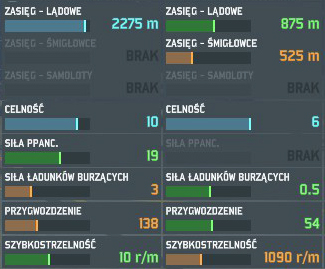
Range (land, helicopters, aircrafts) - possible distance of firing at particular types of enemies. Only barreled artillery (and Canadian anti-aircraft system) can attack all types.
Accuracy - basic factor of chance for hit: the higher, the better. Every point stands for 5% chance of hit. It means that with 10 Accuracy (very high), you have 50% of chance for hit. There are also factors modifying the base Accuracy, like: experience and morale of the unit (more in the chapter "Terrain, morale and maneuvering"), movement and a stabilizer (more in the chapter "Terrain, morale and maneuvering").
AP and HE power - base level of damage dealt to, respectively, armored and unarmored enemies. If a missile with 10 AP hits 8 armor, it deals 2 damage. But if the target has armor 1 or 0, the damage is multiplied by 4. Effectiveness of anti-panzer weapons depends also on type of ammo (kinetic or cumulative; more about it later on), but the case with armor 1 or 0 is used with both types of ammo. High-explosive ammo has a little impact on armor, but they can affect an area of unarmored targets. The weapon is anti-panzer or uses high-explosive charges.
Nailing - chance of causing trauma depends on this factor. The higher factor, the quicker enemy morale drops down. Value is presented in relation with a single shot.
Fire rate - number of missiles fired within a minute with reloading time included. In case of artillery - number of missiles for a single salvo.
Weapon can also have additional features:

Kinetic - weapon firing kinetic anti-tank missiles. Anti-tank power increases with losing every 175 m of distance from the enemy. At the distance of 375 m, every weapon using anti-panzer ammo will deal at least 1 damage.
Cumulative - weapon using cumulative missiles. Independently on AP power, it deals at least 1 damage. Distance doesn't affect the damage dealt.
Area of damage - weapon firing explosive missiles damaging infantry and unarmored vehicles in some particular area. It won't damage armored targets, but it may stun them.
Smoke - you can also fire a smoke missile (default key: B), which doesn't cause damage but blocks the field of vision of enemy land units. Only artillery and mortars may use this.
Improved fire - indirect fire over obstacles may be more effective, if the target is seen by other unit. It affects only artillery and mortars.
Guided - missile guided on target by an operator, who has to be still until the impact is made.
Fire and forget - the missile doesn't require an attention of the operator after being fired. It relates only to rockets.
Semi-active - rocket may be fired while moving, but the target must be pointed out (guided) by the operator to the moment of hit.
Radar - weapon using radars, so it can be destroyed by SEAD missiles. To avoid it, you can turn off the weapon (click on its icon during the fight).
SEAD - anti-radar missile is guided at the enemy radar until it's not turned off. Units with this missiles often open fire at the first enemy with radar on.
Stationary - user must not be moving to fire.
Napalm - every incinerating weapon, but not necessarily basing on the napalm itself (for example thermobaric rockets, flamethrowers). Spreading-out fire decreases morale of even experienced units.
Technology has a lot of weapons:

Howitzers - they fire salvos with few missiles for long distance (from dozen up to forty kilometers) over the terrain obstacles. Missiles cover some area of damage and may be smoke. Howitzer is a basic weapon of self-propelled artillery, but it can't fire while moving.

Mortars - light artillery firing over the terrain obstacles. It has smaller range (several kilometers) but it's more precise due to the smaller spread of missiles. Average reloading and targeting time, better accuracy with observer. It fires only in stationary position. It's a good support for infantry fighting in the city. Basic equipment of carriers with mortars.
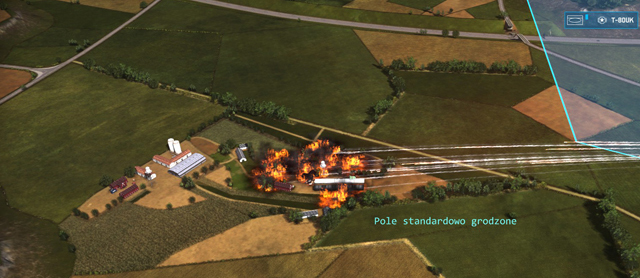

Multiple Rocket Launchers (MRL) - consuming a lot of supplies and slowly reloading weapon firing a whole bunch of rockets at once. Rockets fly over terrain obstacles. As like the others weapon of artillery support, it has to be stationary while firing. Special weapon in this category is TOS-1 Buratino with incendiary rockets.

Anti-Panzer Guided Missiles - precise weapon for destroying tanks and other land technology. Those rockets have cumulative heads, guided in different way (Guided, Fire and Forget, Semi-active - two last types in some of assault helicopters also - Ataka rockets V [Semi-active] in soviet Mi 28, Hellfire rockets [Fire and Forget] in AH - 64 Apache and recon OH 58 - D Kiowa Warrior), with range of 3 kilometers. Equipped by helicopters, tank destroyers, some tanks, some armored carriers, some units of mechanized recon and some command vehicles (e.g. BMP-1K)

Air-to-Surface Launcher - weapon of medium and long range, destined for destroying air targets. Precise, can be Guided and used in mode Fire and Forget.

Main Cannon - fires with anti-panzer missiles (Kinetic) or with high-explosive shells (rarely) to land targets. Its range can be divided onto three categories:
-1925 m
-2100 m
-2275 m

Flamethrower - fires a stream of incendiary substance. It's a weapon of vehicles with flamethrower.

Recoilless Cannon - Mounted on tan destroyers is used against panzer enemies. It has no guiding system (smaller accuracy) and has shorter range than the Anti-Panzer Guided Missiles.

Automatic Grenade Launcher - the name tells all. You don't have to reload before every single shot. Grenades has a lot of HE power affecting an area. They are used against unarmored and living enemy, on the contrary to anti-panzer grenade launchers.

Rocket Pod - multi-barreled launcher of not-guided rocket missiles carried by aircraft and helicopters. It has area of damage.

AGM - precise anti-panzer rockets Air-to-Surface. Equivalent of Anti-Panzer Guided Missiles for aircraft and assault helicopters but more powerful and with better accuracy and range.

AAM - rockets of for air fight (Air-to-Air-Missiles) carried by planes (and also by a prototype helicopter AH 1W Supercobra) differently guided with small (2, 8 - 3, 5 km), medium (5-7 km) and long (up to 12 km) range.

High Explosive Bomb and Laser-Guided Bomb - with a big amount of explosives, destroys infantry and unarmored targets. Normal bomb is dropped just over or just behind the target. The laser-guided bomb can be fired from several kilometers and is guided.

Anti-Panzer Cluster Bomb - bomb, which after dropping, ejects smaller submunitions able to destroy or damage armored targets on the particular area. It won't destroy tanks with better armor, but may decrease morale of their crews.

Napalm Bomb - napalm bomb which, dropped, fires the particular area and the fire spreads out, the quickest in cities and forests, slower on the meadows. The smoke limits visibility and the fire itself may stun or frighten enemy.

Anti-Radar - anti-radar missiles used for destroying anti-aircraft vehicles using radars. They are guided automatically against SEAD targets.

Gatling, Coupled Cannon, HMG, UMG - firing weapons of different range, accuracy and firepower. It destroys infantry and helicopters and is Kinetic. If it's rate of fire is big, it can very quickly lower the enemy morale and stun him.

ADATS - like the barreled anti-aircraft artillery, can attack land and air targets, but, on the contrary, ADATS bases on guided missiles. Only in Canadian M 113 ADATS.
Infantry has, in general, main (firing) weapon and additional weapon (e.g. anti-panzer). It can also carry team weapon, like a machine gun (like RPK-74).
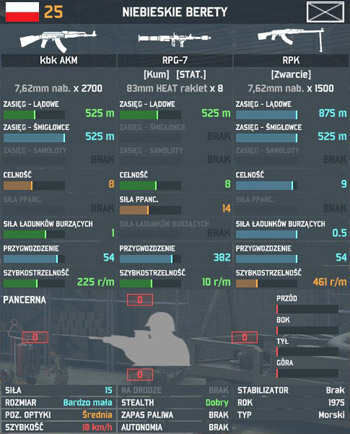
Type of the main weapon using by the particular troop affects the way it deals with different battlefield conditions. So:
Additional infantry weapon may be used against machines (anti-tank, anti-air weapons) or enemy infantry. Anti-tank weapon is, in majority, rocket and recoilless launchers. You can divide them as following:
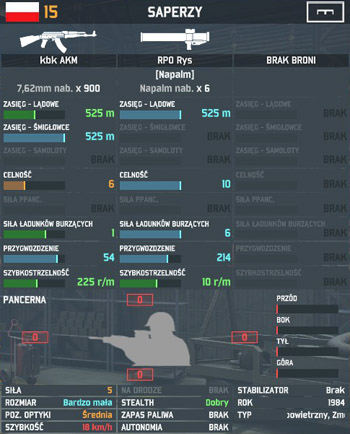
Anti-tank sections have also air-to-earth launchers. They have, in general, lesser range and power than the anti-air missiles mounted on vehicles, but they are not guided by radar.
Some troops have additional, anti-infantry weapon. For example, polish sappers armed with thermobaric launchers (modern equivalents of flamethrowers used during the Second World War). A missile fired from the launcher spreads a cloud of flammable substance at hit (which starts burning at once). Thermobaric weapon is perfect for destroying reinforced positions of infantry - its usage frightens enemies what decreases their defensive abilities.
A good leader knows how to use terrain as his asset. That's why, you have to know how different types of terrain affects the battlefield.
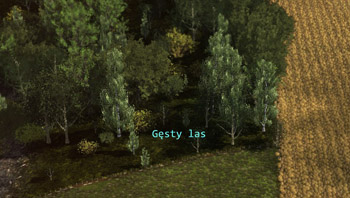
Forest gives you the best possibility of hiding inside. A troop of infantry or recon inside is almost undetectable from outside. Heavy machines move with effort in forest. You can burn forest down (for example with napalm) - the fire spreads out gradually and gives minuses to morale for troops inside of it. Due to the natural camouflage it provides, it's perfect place for ambushes.
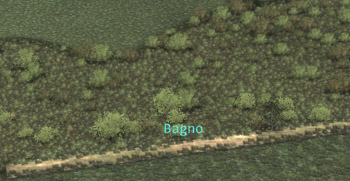
Swamp is worse hideout than the forest but it's an obstacle for vehicles. The latter ones may be also immobilized in here when they lose a caterpillar track. \\
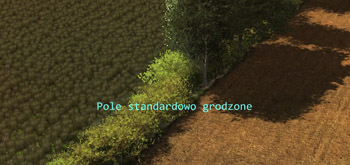
Standard field allows you to hide, but it's not as much effective as a forest or swamp. But it's less obvious place for an ambush than the two listed above (it doesn't stand out from the background when you look from a distance) and that's why is less probable to be detected or bombarded in advance.
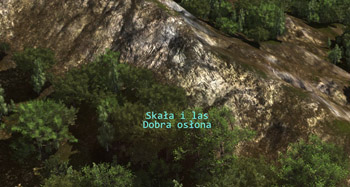
Mountain terrains are barrier for vehicles, but not for the infantry. It can be a good observation point for this type of army; they also may provide a safe march through route into other sector. But you have to make sure that troops in mountain have a good angle of line of fire so they can fire at the enemies below.
When you move a cursor over a terrain, you'll get an information about camouflage - if particular terrain provides any, cursor's color swaps from grey to blue.
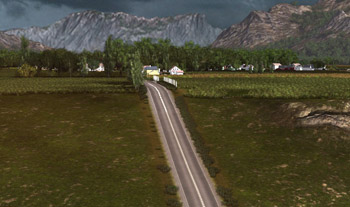
Only roads allow mechanical vehicles for maximum speed. That's why, they are very important point on your backs, where are your reinforcements located. They allow you also regroup and transport quickly land forces to more endangered locations.

Urban terrains (villages, city's settlement) can be changed in perfect defensive fortresses. Only infantry can take over buildings and fire from inside of them and, what is more, is hardly detectable and difficult to identify. Areas of city/village are divided into particular sectors of various size (several buildings, corner of the street, a single block). The sector may be conquered only by one group of infantry (up to 4 troops). Soldiers can move quickly within a single sectors and between them. If a particular sector borders with sectors occupied by enemy, it may be fired at and assaulted from all of them simultaneously. During bombarding (with conventional weapon/napalm), soldiers run to the less endangered part of sector, so you have to cover the whole sector equally with fire or aim carefully. Sectors' borders are marked with lines: white are for not occupied, and red/blue defines the side of the conflict.
Besides using the environment and buildings, you have to remember about the shape of the terrain. In general, higher terrain gives you better view and unit can watch over obstacles.
Each unit (if lives long enough) learns on the battlefield. It reflects in experience levels of soldiers. Staying under fire or, in general, taking part in fight increases unit's experience. In practice it affects unit's statistics like accuracy, rate of fire and, what is more important, keeping a cold blood in risky situations (better morale regeneration, read more below).
 Levels of experience
Levels of experienceAccuracy growth for particular level of experience may be presented in the following way:
Rookie - none
Trained - 10%
Hardened - 26%
Veteran - 36%
Elite - 60%
The game calculates also influence of battlefield stress on particular soldiers. Left under fire, seeing the dying friends, nearby fire or usage of scary weapon decreases the morale. Those factors cause different emotional states which affect accuracy and firerate as following:
Calm - no changes
Worried - 33% longer reloading
Shaken - twice longer reloading, 36% lesser accuracy.
Panicked - four time longer reloading, 50% lesser accuracy.
 They won't run away
They won't run awaySome types of weapons (quickly firing cannons, napalm, rockets) can easily stun or even force the troop to run away. Stunned troops can't receive orders for several precious seconds. Escape makes the panicked troops not only ignore player's orders, but they also try to find their own solution to the problem (what, in general, ends up in getting killed). Skilled stunning enemies let you eliminate theoretically more powerful but inexperienced troops. The higher nailing factor, the faster it make the enemy morale goes down.
What is more, every unit may suffer from additional, critical effects like optics failure and others.
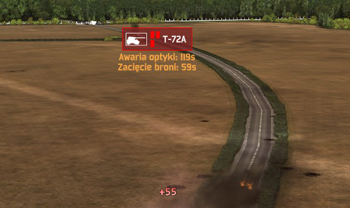 Critical effects
Critical effectsBeing under fire or decrease of the morale cause that unit can't use a repair or ammo resupply fir 40 seconds.
In the campaign, access to experienced units is limited by leveling up only on the battlefield. When you make your own deck, you can put in your more experienced units at once. The limitation is a mechanic which makes experience level dependant on the number of people in the troop. If instead of troop of "Trained" you choose a squad of "Elite", your troop will be smaller. So, you can choose a squad of American Riflemen who has 20 sections of "Trained" or the same one, but "Veteran" which has only 12 sections. What is more, some troops may not be chosen under the particular experience level (e.g. Delta Force only Veteran or Elite). Also the choice of bonus while creating your deck increases the basic experience (when you make a particular type of a deck). So the whole trick lies in a proper set up of your forces to ensure both high effectiveness and a lot of people (the more soldiers, the better firepower). You have to also remember about the kind of tasks for the particular type of army. Infantry troop may be larger and less experienced if they are only about to secure e.g. a crossroads where your supplies will be moving at your backs. On the other hand, assault troops should be more experienced. And you have to always avoid totally untrained troops because they lose morale very quickly and are more susceptible for negative effects.
Independently on the bonuses for fire rate from experience, some types of infantry (recon) got an additional bonus to this statistics.
 Parachutists are quick...
Parachutists are quick...+50% bonus to fire rate in comparison to the regular infantry.
- FR RIMa, Commando-Para
- URSS VDV, Morskaya Pehota
- US Marines, Rangers
- CAN Vandoo, Pathfinders
- UK Green Jacket, Paratroopers
- RFA Panzergrenadier
- RDA Mot.-Schtzen, Kommando-Aufklrer
- TCH Vysadkaru, Pruzkumnici
- POL Blue Berets, Parachutists, Assault Sappers
- NOR Stormer
- SWE Fallskarmjagare
- DAN Livgardere, Gardehussare
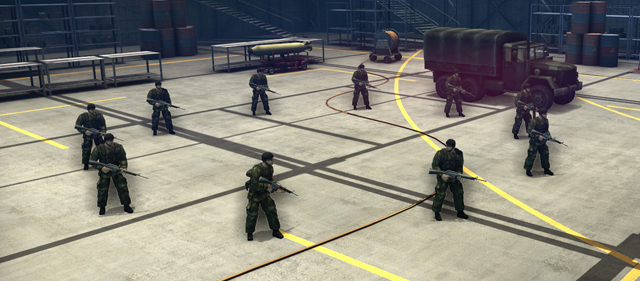 ...but Delta is faster
...but Delta is faster+100% bonus to fire rate in comparison to the regular infantry.
- US Delta
- FR Lgion
- UK SAS, Royal Marines Commando
- DAN Jaeger
- URSS Spetsnaz, Spetsnaz VMF
- RFA Fernspher
- SWE Kustjgare
- TCH Specialni Jednotky
- RDA FJB-40
- NOR Marinejegeer
You have to also remember that experience has no influence on equipment changes or upgrading, for example, an armor and maximum range. So both rookie and veteran will fire from RPG 7 on a distance of 525 meters.
I mentioned that surrounding may affect ability of detection or speed of moving. I have to add several remarks about moving vehicles. There are several modes of moving. In the right bottom corner of the screen you can find a panel with basic and advanced orders.
 Order menu
Order menu
"Quick movement" (key;) - vehicles will head for the closest road where they form a column.
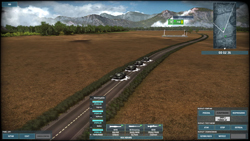 A column
A columnIn such formation, they use their max speed after reaching a road. It makes them almost defenseless.
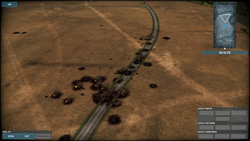 And column is done
And column is doneAttacked troop has to break a line (spread out what doesn't happen immediately) to open a fire (one tank is too little). They also become a very easy target as the thickest armor is their front one. There is no need for many series to destroy the whole column of powerful tanks if you caught them from surprise and attack from sides; and there are also area attacks (bombarding, rockets). You have to remember also that with "Quick Movement" troop won't automatically begin fighting the enemy it meets (it ignores the danger). But when you play it very carefully, it lets you get your supplies and reinforcement reach the particular place extremely fast. This mode of movement may be used in the beginning phase of battle to take over a sector quickly (after a reckoning). And remember, that wheeled vehicles are faster than the tracked ones.
"Attack" (default: Q) - the vehicle is moving and attack every enemy it spots. On the contrary to the normal movement, the machine stops after spotting an enemy and then fires. It has a great meaning if you have tanks with a weak stabilizer (or without it). Approaching the particular target, tank may always fire, but the chance of hit depends on the type of stabilizer.
Type of stabilizer affects the percentage chance of accurate shot at the maximum range in the following way:
No stabilizer - unit has 5% chance of hitting.
Bad stabilizer - unit has half of accuracy while moving.
Medium stabilizer - unit has accuracy while moving lesser about 50-25 percent from the base.
Good stabilizer - unit has accuracy while moving lesser about 25-15 percent from the base.
Very good stabilizer - unit has accuracy while moving lesser about 15-0 percent from the base.
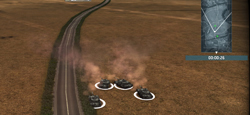 Back
Back"Back" (G by default) - command which allows you to ride back. It has a crucial meaning, because armor is toughest at the front. Normal returning means, that units turn their fronts into the direction of riding. It means, that their weakest, back armor is exposed. When you use "Back", the vehicle doesn't turn, but puts a reverse gear and, if has a stabilizer, can still fight. Doing so, you can retreat or draw enemy into an ambush.
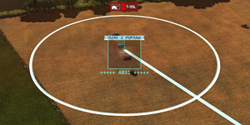 Area of destruction
Area of destruction"Fire" (T by default) - it's a forcing of fire, independently on the cursor's position. It's used mainly with artillery and other units with area attack. When you press "Fire" and show a random point (in case of artillery this point has to be properly away), you'll see a circle where the missiles will fall. This order is important due to the fact, that sometimes you can only sense where enemy units are.
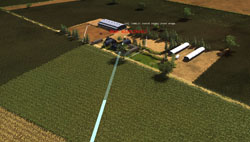 Blue line is a range of fire, transparent is field of view and dots are for blocked field of view
Blue line is a range of fire, transparent is field of view and dots are for blocked field of viewIt allows you also to look at the line of fire of the particular unit, of field of view and weapon range. You can, for example, check if your units aren't too deeply in the woods so they won't be able to fire at enemy which they see.
Area attacks are linked with moderate use of formations (formation menu is slid out by the key over the movement commands).
 Normal formation
Normal formation"Dispersion" (X key) - normally, units in one troop are very closely to each other.
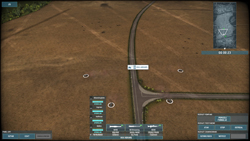 Dispersion
DispersionOrdering a command "Dispersion" makes your unit break their regular formation and spread out, but remain the same troop. This command is very important, because otherwise your troop may be easily neutralised by bombs, napalm or rocket attack; in such case all squad may be destroyed or stunned at once.
Ordering a command "Assemble" (R key) - joins single units into one group (but no bigger than 4). Using this command is worthless, due to the risk of bombardments and attacks described above. What is more, it's highly not-effective due to the fact that when such a group attacks smaller groups, it takes much more ammo to eliminate enemy. You shouldn't group up recon squads, as they don't detect enemies better and are more detectable when larger. There is one exception in case of infantry. Infantry fights better in bigger groups during urban encounters.
I have to also say few words about movements for planes and helicopters.
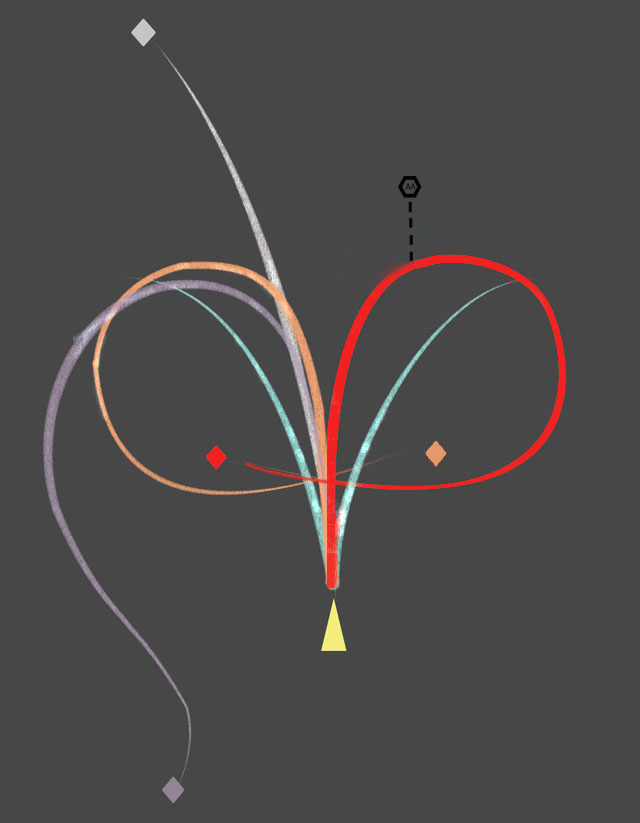
The schematics above shows how the plane moves while turning. Its reaction depends on the maximum angle of turning (blue lines above). If you won't to not fly into anti-flight cannons (black hexagon), click on the left side of a plane (red rhombus). Plane can't take such narrow turns, so it makes a circle (red line) almost over the anti-flight position. When you know how the plane behaves, you can make something similar by clicking on the right side of the plane (orange rhombus and orange line) but it's highly unintuitive. And if you click on left far in front of the plane, it'll fly deep into enemy's territory (grey line), what may be dangerous. The good move is to click on left side, behind a plane and then the turning angle will be proper and he'll turn into desired direction (violet rhombus and line).
 Pink route - Air-route
Pink route - Air-routePlanes get into battlefields via air-routes with the defined direction. They won't throw bombs while turning and have to approach targets in straight line. Stunned pilot can't attack, can't fire rockets. That's why, it's good to have a anti-air artillery with high rate of fire, because it may stun the pilot before he reaches his target. When the ammo runs out, plane leaves the battlefield. You can also order it to retreat immediately (V key) due to various circumstances. When it leaves the battlefield, it gets new weapon, is fueled, repaired. This process takes different amount of time, depending on damage and usage of resources.
Helicopters also have their turning angle while moving. If they hang in the air, they can turn very quickly. When they are in rush, they won't stop at once with order "Stop" (E key). In the phase of dislocation, placing them over the forest put them immediately in the air. Otherwise, they have to rise up what may take several precious seconds. They can also operate on two different altitudes, which can be changed by the proper order (Z key). On the lower one, helicopter is closer to the terrain what makes him less visible but also limits his field of vision. On the higher, his vision (and range) is much better, but the helicopter is visible and endangered. After a while of doing nothing, helicopters tend to lower altitude automatically. If it's on the ground, it may be attacked and destroyed as any land unit.
Without recon, you can do nothing, no attack will succeed and no defence. Spread out your recon, secure all directions and prepare for unexpected. When you choose units, focus on the level of optics (good optics is almost no optics for recon) but remember also about detection level.
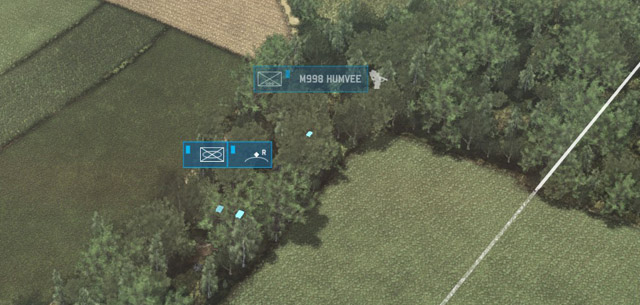 HUMVEE is hidden, the rest is not
HUMVEE is hidden, the rest is notDetection isn't that horrible, because enemy may not notice that he spotted you. In such a case, you can try to eliminate him quietly and if you make it quick enough, your opponent won't know what he is against as you disappear again.
Of course, don't group up recon units, because it does not improve the detection ratio.
Hide also your command vehicles, cause they will be hunted. When you lose the last of them, you lose. Avoid using them in fights, even if they are powerful tanks. Their armor mostly protects them against the first artillery series.
Recon helicopters have the range of vision but they are visible from earth. You can use them to fly over lakes, mountains and at the edges of the map to get at the backs of enemies.
Avoid grouping up units whenever you only can. If you do group up them, any unit with area attack may neutralize all your tanks at one due to the stun effect. Stunned unit is worthless and very easy to be destroyed. In this way, enemy may very easily crush your panzer army. So spread your units but in a distance which allows them to secure one another. While moving, units in one troop will move to the directed point via the quickest possible way and after getting them group up. That's why you should divide troops and sections on smaller ones and command them one by one.
When you set up units, avoid also obvious hide outs (like the only one forest in the sector). Swamps and some fields are also good hide outs and what is more they are difficult to spot from the distance.
Notice also from where and what way your units travel because they may ride carelessly next to the enemy who is firing at them.
Remember about differences within the sides of the armor on the vehicle and try, if you only can, to flank enemy or attack from behind. You can also get him into ambush by retreating. To do use, use maneuvers.
I mentioned that the most expensive tanks are universal. But it's not only about statistics, you have to also be tricky. You should always have different types of tanks and use their advantages to defeat a well armed but not that good at commanding enemy. It's easy to lose expensive units in ambush but it's difficult to replenish loses. That's why you have to consider thoroughly advantages and disadvantages of your and enemy tanks. Tanks are defined by armor, mobility and firepower. Armor stands for endurance, mobility comes from speed and stabilizer quality while firepower combines the main cannon, accuracy anti-tank power and rate of fire. Only universal tanks are good at all three statistics while the rest has one or two weaker. tanks with low mobility and good armor and firepower may be used for position defence and ambushes. Tanks with medium cannons but with good armor and mobility are good as moving shields to destroy enemy tanks from distance - approach an enemy to neutralize his range asset. Your armor may resist many damage while you deal more damage at short distance you're your cannon fires kinetic missiles). The third type of vehicles are ones with good mobility and firepower but weak armor. Just fire and run with them.
Don't hurry to fight supertanks on uneven terrain. You'll have difficulties in positioning and proper fire angle even if you have higher position. You'll lose fire advantage and even the toughest armor will be crushed from below. The tanks riding up (or down) on the hill can't fire. If you have to surpass narrow slopes, use a smoke cover.
Don't think that enemy trucks will be full of soldiers - firing at them will show enemy your position and you lose a lot of ammo.
Besides helping infantry in urban fights, use your artillery to support your maneuvers. Mortars won't destroy well armored targets but they may help tanks and other vehicles. They have high rate of fire and you can stun enemies with them. Smoke cover will let your troops regroup to defence or attack. Fire the smoke and approach enemy with armored tanks (even AI does so). Medium-range cannons have more firepower, but worse rate of fire and uses more supplies. Their smoke covers bigger area. Long-range cannons (30-40 km) may be used to destroy enemy's artillery. To do so, observe from where the missiles are coming and fire at that place. Move your cannons after every series, because enemy will counterattack. Heavy artillery is very precise and can destroy even tanks unless they move quickly. This type of cannons has the smallest rate of fire.
While it comes to the anti-air defence, create a zone with rocket launchers in the middle and anti-air cannons on the edge. Combine and mix weapons with radars with the weapons using infrared and without any detecting device. Such a combination will make more difficult to destroy your defence for aircraft. Notice which planes are designed for that and eliminate them before your defence goes down. Remember also that you can turn off radars and avoid being detected. Support the whole thing with spreaded anti-air sections. In particular, focus on mountains unavailable for vehicles. Although anti-air sections have small range and cant fight planes that effectively, using them may make an impression of unbreakable defence. Secure the edges of the map against helicopters raids. To defend anti-air sections against recon or commands you can use transporters or helicopters.
Use also helicopters as a support for infantry, especially for destroying tanks. As they are very fragile for aircraft, use them in your anti-air defence zone. You can also create a lone helicopter team with recon helicopter to raid enemy at his backs.
Use your helicopters wisely, so they don't fly deep into the enemy territory when they can get several rockets in the face. Using your area weapon try to his as many enemies as you can. Use the situation where enemy has units placed in one line.
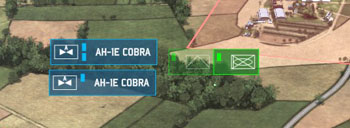 Ally is marked with the green color
Ally is marked with the green colorCooperate with your allies. In dislocation phase use flares to show direction in which you want to attack, what you want to defend or what you want to conquer so it won't end up in situation when you attack one point and enemies are passing you by. Flares can be chosen from the menu shown below (below the minimap).

Flare with keyboard allows you to input message. Write what you want, confirm with enter and place the flare on the map. In this way, you clearly shows what you want to do. If you hear a signal of flare or a siren, you can center on this event by pressing space.
Sooner or later you'll fight to conquer a city. Both in attack and defence, the infantry is your main strength.
Basic information about cities may be found in the chapter about terrain.
First of all, eliminate the enemy around the city so you have a rather safe way. Recon won't be useful because it can't detect infantry in the city. You have to send something cheap to lure enemy out. Use the smoke screen aiming at the edge sectors to which you want ride in. Smoke should be between your transporters and enemy infantry. Using your artillery is a must to decrease defenders' morale. Your infantry in cheap transporters should attack the side sector, covered by smoke from inside (and also from the side of enemy) with choosing "Quick movement" command. Transporters stop at the chosen sector when you order them to unload (U key) infantry will immediately get into the sector. If there is an enemy there, battle begins (violet edging of the sector), so it's good if you have appropriate units making it. Support infantry with precise mortar fire at nearby sectors. What is left of your transporters, should be taken out of the range of grenade launchers. Don't use expensive vehicles for that, they are destroyed as easily as the cheap ones. Send next waves of infantry, so one bombarding won't kill all of them (if your defence isn't tight enough). You can also try to attack massively and try to take more than one sector at once. Surround the city and isolate it, at least 800 meters for all technic devices/vehicles, keep especially helicopters away from it. Fire from everything with destroying missiles, spread fire, decrease morale. Have a numerous advantage and prepare for losses.
Nearby forest may be also used in attack at city, remember also about the smoke cover. You may think that city is close to you. In reality, it may be few hundreds meters within which your army will be massacred.
You can also try to take over city quickly via air forces. To do so, use infantry (or commandos) in helicopters. Don't forget about recon helicopter and an escort to defend it against other helicopters. You can also take assault helicopters, which may be useful if enemy will try to seize the city with land forces at the same time. This option is viable if you know that there is no anti-air defence nearby the city.
Defence is much easier. City must have several anti-air sections with infantry on the borders. Place also tanks nearby to take down enemy transporters. Use helicopters and bombers for quick eliminations. Secure nearby forest so the infantry won't get unspotted to the city. If enemy gets inside, move troops to make the biggest possible number of them fire at enemy simultaneously. Care about ammo supplies, because those fights are very intense. If enemy prepare artillery attack, you can retreat to the other sector. That's why you shouldn't max crew in sectors.
 Strategic View
Strategic ViewAlmost every of four available campaigns is about taking crucial cities in within some particular amount of days (only the last scenario is defensive one, where you have to defend the city). It's only a theory, because sometimes you don't have to conquer all of those cities. In the right upper corner you can find information about the day and fraction's morale.

Number on left shows how many points you got (or have from the very beginning), on right, how much point you have to get to achieve a political victory (win the scenario). Getting one of the city marked as the main goal gives you a lot of morale points. But not only that. Also destroying enemy brigade gives you some morale points. It means, that you can win the second scenario without conquering Stockholm.
Each next scenario you begin with smaller amount of points and bigger limit to get, so it's harder and harder to win only by destroying enemy forces. Due to that, campaign gets longer and harder.
Few words also about brigades dislocation. Only airborne brigades may be dropped at any area. Remaining one will begin only in ports or airports you have in the any sector on west (NATO) or east (Warsaw Pact) Scandinavian coast, in border sectors or some defined sectors. In general, you can expect reinforcements from west and south (NATO) and east and north (Warsaw Pact).
Brigades are imposed and have some particular profile. Armoured: lot of tanks, mechanized: the most universal ones, airborne: a lot of aircraft and helicopters. When fighting armoured ones, expect rather good tanks, in the remaining ones tanks are rather weak.
NATO has, in general, light brigades, while Warsaw Pact has much more armoured units.
You have some part of army from the very beginning and you can buy the rest units in following days (turns) of war if you have enough political points. You get there every day for controlling sectors (normal sector - 1 point per day, entrance sector - 3 points, capital - 6 points). For this points you can also buy special actions for particular sectors. One of most useful is, for sure, commandos attack, because it immobilizes every brigade on the chosen sector. In general, it's good to have new units as you can win battles with them.
Initiative is responsible for amount of dislocation points you have at the beginning of every battle to set up your units. It may be increased by Rest order and calling reinforcements (brigade loses turn in such a case) and it decreases with every battle. With numerous battles, it may drop even to 250 dislocation points for battle what means that enemy will outnumber you if he has any fresh brigades. This advantage may be, in some cases, neutralized (read further). If you attack one brigade with three, you get one initiative point for each of you but enemy will lose three points, even if you can't destroy him.
Besides a fraction's morale, there is also brigade's morale. The higher it is, the less number of enemies you have to destroy in battle to win. Loses are counter basing on unit value in dislocation points. So morale stands for the upper level of those points.
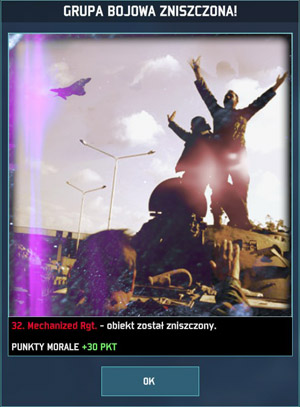
Only total victory forces enemy to retreat (what is more, winner's morale increases about 3 points and defeated drops about 3 points), who may be eliminated if he gets attacked by other brigade and sector to which he retreats isn't occupied by an ally unit. So even if you win (big win +2 morale, small win +1 morale), the battle will follow the next day. Draw (each gets -1 initiative and morale) is every battle in which no one gets an upper limit of points for destroying enemy units. The lowest level is 750 dislocation points.
Adjust type of brigade for the target you want to take over. In the third scenario, 7 Naval Assault Division when takes over Stockholm, may defend against several brigades at once, getting total or big victories.
Notice also composition of your brigade. Mentioned above 7 Naval Assault Division has 8 troops of recon in assault helicopters Mi 24 in bookmark "Recon".
All tactical hints from previous chapters are also to be used against computer, but with some adjustments.
AI is likely to attack if it has armored and mechanized units and defence (or play passively) with light brigades. Do likewise and adjust your tactic to the surroundings.
Using tanks and motorized devices, AI uses roads even when attacking, but don't count on the fact that there is no anti-air defence. It likes also to patrol roads with vehicles having anti-air devices on the board.
But AI conquers sectors very quickly (if aggressive) and can also try to attack from many sides. If you have to defend, prepare and upgrade all the time, because it happens that AI attacks with all forces in last minutes.
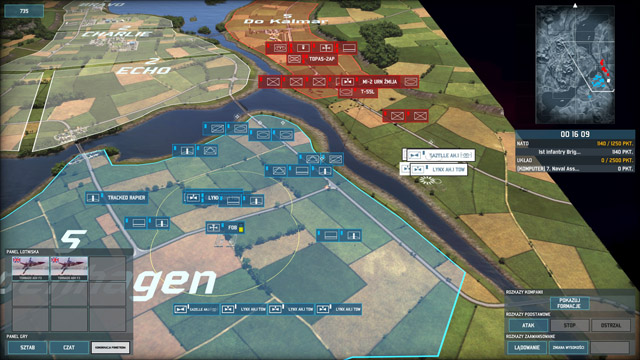 Slaughter
SlaughterIf one of your beginning sectors and AI sectors are neighbours in the dislocation phase, be sure that AI will place there a majority of its units. In such a case, leave there a lot of tanks, helicopters and everything else to fight against vehicles, don't forget about the recon and anti-air defence. Then, the fight will be very quickly and result may be very profitable for you. In this way, in the scenario Fortress Stockholm you can crush 2 enemy brigades within one or two days. It's enough to attack Aarhaus 3rd Commando Brigade (very well placed helicopters massacre enemies) and immobilize with "commandos attack" invade in Malmo with your 1st Infantry Brigade.
When you lose a unit, you lose it for good (there are no resupplies). Use it to plan ahead. If you have a light brigade, which is rather designed for static defence and the battle with the same enemy takes already several turns, try to eliminate crucial enemy units like anti-air defence. If you succeeded, then maybe in one of further battles, you will massacre this brigade with some cheap bombers. Thanks to that you get an advantage over AI, who does not think in that way. Of course, don't risk your units for nothing, sometimes draw is a good result.
Hunt down command vehicles. Lost of it is a immediate brigade destruction.
I mentioned that you can neutralize an initiative advantage. So, in each following battle you have the sectors you took in the previous one if you place there a command vehicle. The more sectors you have, the faster you regain dislocation points and put new units into the battle. If you expect a draw, take over sectors around and may be as the time passes, you'll be able to conquer a sector next to the enemy's ones. Then you can use a tactic of immediate destruction described above, whatever tools you have to use.
You can set up artillery in one place and don't bother moving it around. AI will attack only what it can see. That's why, you can place your units in obvious ambush locations (cities, forests) and be sure that you will surprise enemy.
Sometimes it happens that AI places a group of soldiers in forest for an ambush, don't expect it too much as well as don't expects raids of commandos or helicopters at your backs. Computer player doesn't also use forest for hiding movement of his troops.
AI also doesn't bother about setting up units in the safe distance. While waiting for you, it places vehicles like on the parking lot (even infantry in trucks!). You can try your artillery on that. It rarely moves further to avoid your cannons.
Before you start creating your own deck, I recommend to play campaign a bit. You find there all nations with their defined units so you can test their advantages and disadvantages personally. You can also test authors' decks. You should also notice that there can't be a deck with everything you want as each choice creates some powerful things and weaknesses. Many hours of experiments let you create your own style.
Click "Deck" button to open deck creator. Here you have five more options to choose:
"Create" - create new deck
"Edit" - edit a deck which already exists
"Change" - change the name
"Delete" - the name speaks for itself
"Copy" - copy the deck for editing
Grey decks are prepared by authors as examples and you can modify them after copying them.
After clicking Create, you enter a menu of deck creation. Here you have several options from which obligatory are:
"Faction" (NATO or Warsaw Pact)
"Deck name"- random name, whatever you like
Option Choose bonus isn't obligatory, but it allows you to get additional bonuses for some limits in your deck.
National deck narrows choice of units only to those which this particular nation had in real world, but also unlocks prototypes and let them get an additional bonus. If you don't make any choice, you can mix units from all factions of conflict, but you will be derived of bonus and access to prototypes.
Type defines an army profile by increasing XP and activating points for particular units categories but you don't have slots for other types
Aeromobile - Advantages: additional experience point for recon units. Each plane costs one activation point less. Disadvantages: selection limited only to particular units and only 6 slots for tanks
Mechanized - Advantages: additional experience point for all vehicles, additional experience point for all support. Disadvantages: selection limited only to particular units and only 6 slots for helicopters
Parachute - Advantages: additional experience point for all infantry, each infantry costs one activation point less. Disadvantages: selection limited only to particular units and only 6 slots for support
Paratroop drop - Advantages: Additional experience point for all helicopters, each helicopter costs one activation point. Disadvantages: selection limited only to particular units and only 6 slots for support
Maritime - Advantages: Additional experience point for all infantry, additional experience point for all planes. Disadvantages: selection limited only to particular units and only 6 slots for recon
Armored - Advantages: Additional experience point for all tanks, each tank costs one activation point less. Disadvantages: selection limited only to particular units and only 6 slots infantry.
All - you have access to all types of units..
Era limits an access to units due to the date of their real appearance. You have three choices in here.
No choice let you choose all units and grants an access to prototypes.
Category B includes units which appeared before 1980. Bonus is + 40% to availability of units.
Category C contains units which appeared before 1975. Bonus is + 80% to availability of units.
Availability was mentioned above, in the chapter about experience. In short: the higher availability, the less the troop loses when it levels up.
When you click Create you return to the deck menu, where you can see your own deck, next to the decks of authors. Click it twice.
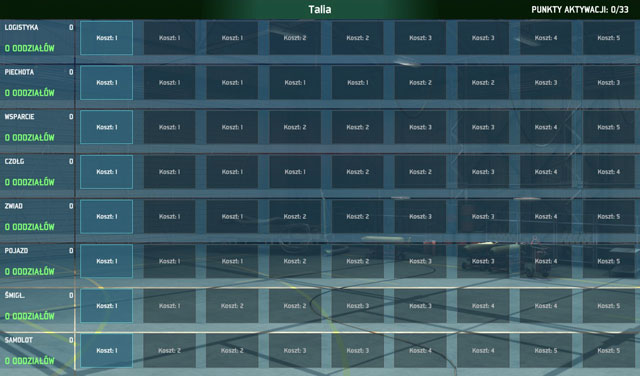
You see a general panel with empty slots and number of activation points (right upper corner). Number of points is calculated including various bonuses. In the central place you can see a table divided by unit's categories and cost which you have to suffer to full the slot with a particular unit. This cost grows for each category while filling slots from left to right. Click on the slot in the chosen category.
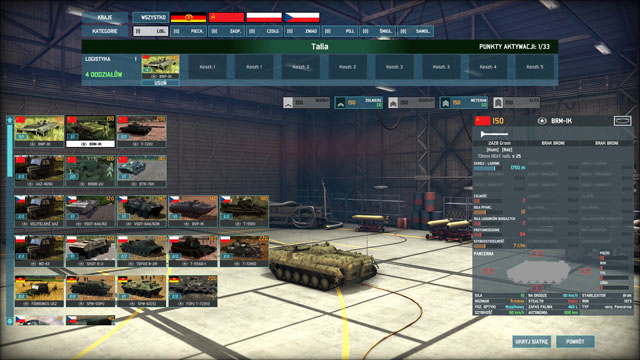
You see a screen where you add particular troops to slots. Clicking on the flags in the upper part of the screen, you wider or limit the choice of units due to the particular country. While creating National Deck you have only one flag there. You can also switch between categories.

On the left side you can see troops you can choose. On their icons you see a cost of summoning them in the battle in the right upper corner. In the left one a number of slots the troop takes slash number of slots which it can fulfill. You can't create a deck with category full of identical units. Troops are added to the slots above. You can observe how the costs are growing and how many activation points you have spent.

A little below you have a bar with ranks for the added troop. Below the name of rank, you can see a number of people in this troop. Higher ranks decreases number of people in the troop. This can be neutralized by bonuses in Era category.
A big panel below those icons contains information about unit.
When you spend all activation points and when you're good with the squad of your deck, return to the general panel of deck by clicking on Return. To save a deck click Exit and remember that every deck has to have some command vehicles.
Several hints for a beginner deck:
- recon should be recon, it has to have at least very good optics and be quick. Invest also in recon helicopter
- have various tanks but resign from tanks with destroying ammo and weak tanks at all, because it's waste of slots
- buy experienced anti-air and anti-tank sections which should fire quickly and accurately
- don't forget about artillery/mortars, anti-air artillery and anti-air missiles of both types.
- buy anti-tank helicopter with experienced crew
- choose whatever infantry you like (but not totally inexperienced) and prefer armored transporters over advanced land attack vehicles
- if you can, buy a plane against anti-air defense
- don't forget about supply trucks (one slot at least)
- don't buy command helicopter
- among tank destroyers, choose those which have anti-tank weapons.
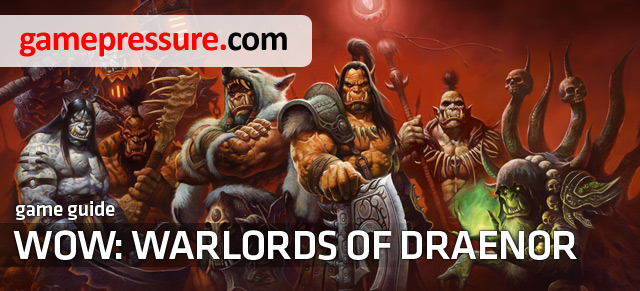

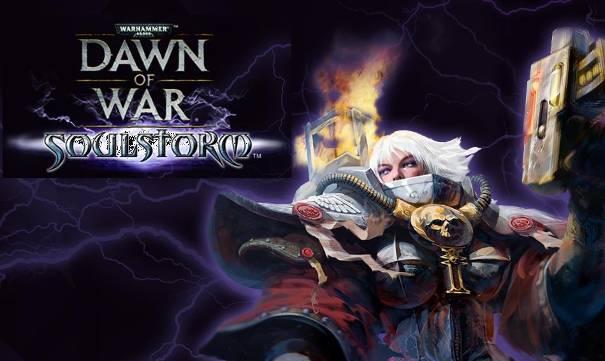

 Warhammer 40.000: Dawn of War - Soulstorm Game Guide & Walkthrough
Warhammer 40.000: Dawn of War - Soulstorm Game Guide & Walkthrough Wolfenstein: The Old Blood Game Guide & Walkthrough
Wolfenstein: The Old Blood Game Guide & Walkthrough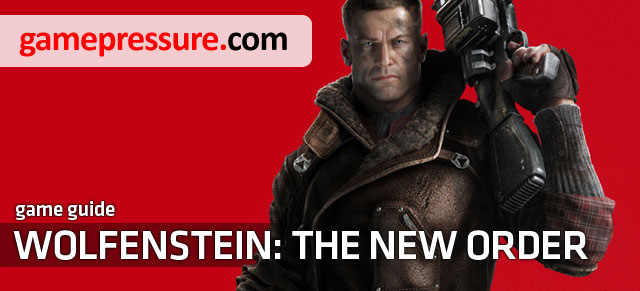 Wolfenstein: The New Order Game Guide & Walkthrough
Wolfenstein: The New Order Game Guide & Walkthrough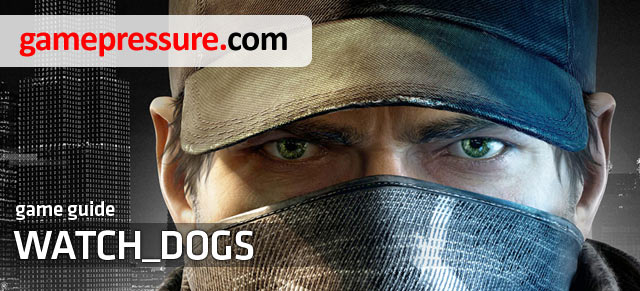 Watch Dogs Game Guide & Walkthrough
Watch Dogs Game Guide & Walkthrough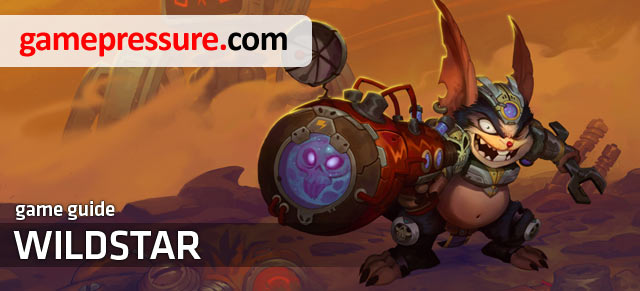 WildStar Game Guide & Walkthrough
WildStar Game Guide & Walkthrough